



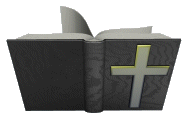

The Tabernacle and the Ark of the Covenant
On the day after Moses returned from Mt. Sinai with the Second Tables, God ordered him to build a place of worship, or a Tabernacle, which was to be a visible emblem of God's presence in the midst of Israel. For this purpose God had asked them for voluntary contributions of gold, silver, copper, precious stones, wool, and linen.
When the people heard the good news, they gave freely of everything useful and precious that they owned; the women also spun and wove artistic handicraft. The princes contributed precious stones, fine oil, and rare spices. Day after day the entire community brought rich gifts as their offerings to God's sanctuary, until the contributions were more than was necessary so Moses had to stop the ceaseless flow of contributions.
God selected Aaron and his four sons, Nadab, Abihu, Elazar, and Ithamar, as priests to serve in the Tabernacle, on behalf of the entire Jewish people.
The Tabernacle was a portable tent with a wooden framework to give it stability. The Tabernacle area was 150 feet long and 75 feet wide. There was a 7 1/2 foot curtain made of fine white linen which were fastened to 60 supporting pillars of bronze surrounding it.
When the people heard the good news, they gave freely of everything useful and precious that they owned; the women also spun and wove artistic handicraft. The princes contributed precious stones, fine oil, and rare spices. Day after day the entire community brought rich gifts as their offerings to God's sanctuary, until the contributions were more than was necessary so Moses had to stop the ceaseless flow of contributions.
God selected Aaron and his four sons, Nadab, Abihu, Elazar, and Ithamar, as priests to serve in the Tabernacle, on behalf of the entire Jewish people.
The Tabernacle was a portable tent with a wooden framework to give it stability. The Tabernacle area was 150 feet long and 75 feet wide. There was a 7 1/2 foot curtain made of fine white linen which were fastened to 60 supporting pillars of bronze surrounding it.
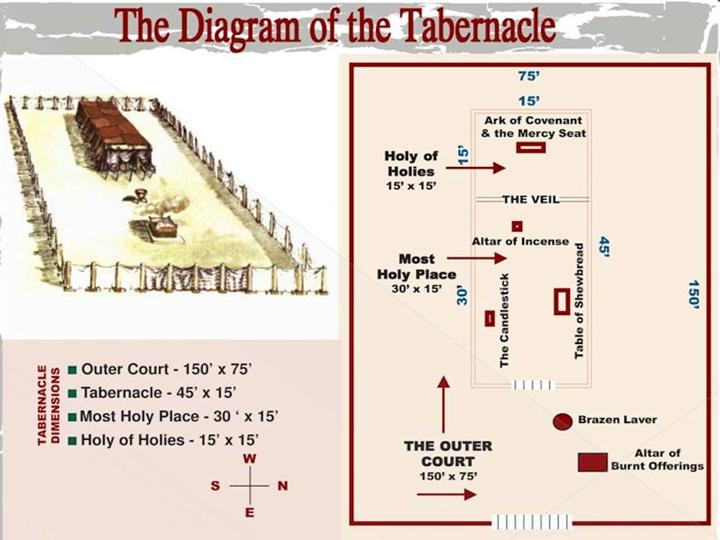
Different views of the Tabernacle
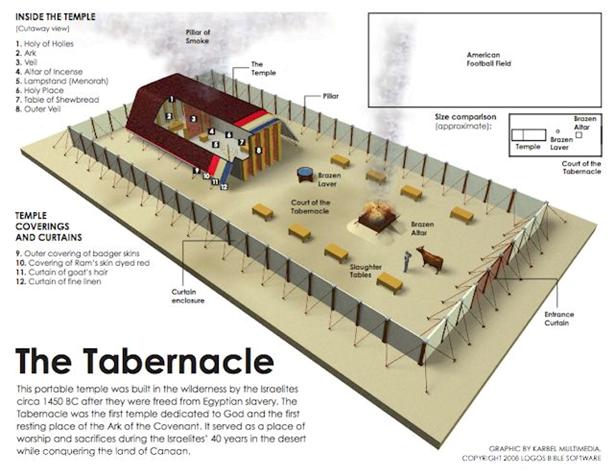
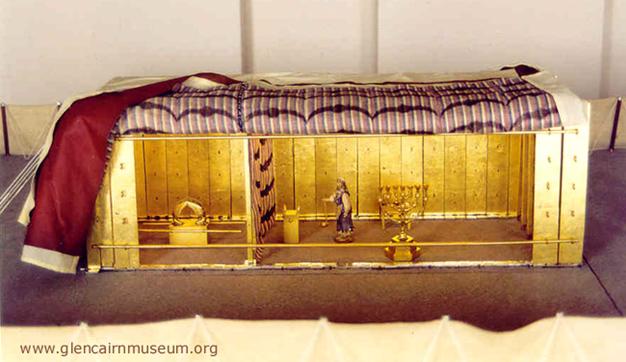
The Tabernacle consisted of three parts:
1. An outer court enclosed by curtains supported on pillars.
†
2.The altar of sacrifice (bronze altar) was within the court, facing the entrance.
†
3. The Tabernacle was divided by a veil or hanging curtain into two chambers. The first chamber
was called the Holy Place, it contained the Table, Lampstand, and Altar of Incense. Only priests
were allowed into this section. The second chamber was called the Holy of Holies, it contained
the Ark of the Covenant. The High Priest entered the Holy of Holies only once a year on the
Day of Atonement.
The objects closest to the Holy of Holies were constructed of precious metals and cloths. Those farther off were made of bronze and ordinary woven materials. The Tabernacle was covered by a tent and additional cloth covers.
Within the outer court were two articles of furniture, the bronze altar of sacrifice where all of the sacrifices were made, and the bronze laver of cleansing where the priests washed their hands and their feet.
The Tabernacle building itself stood at the West end of the court and was a wooden structure overlaid with gold 45 x 15 feet divided into two parts by a heavy curtain called the "Veil." The entrance was a multicolored curtain door hanging on 5 pillars. The bigger part (30 x 15) of the tabernacle building was called "the holy place" and contained three golden articles of furniture. The golden lampstand that shined on the shewbread on the left, the table of shewbread that represented the people of God on the right, and the golden altar of incense that spoke of ever ascending prayers in the back. The smaller part (15 x 15) of the tabernacle building was called "the holy of holies" and contained only the ark of the covenant (the box that contained the two tables of the Law) and its lid, the mercy seat where the blood was sprinkled once per year by the high priest on the day of atonement.
1. An outer court enclosed by curtains supported on pillars.
†
2.The altar of sacrifice (bronze altar) was within the court, facing the entrance.
†
3. The Tabernacle was divided by a veil or hanging curtain into two chambers. The first chamber
was called the Holy Place, it contained the Table, Lampstand, and Altar of Incense. Only priests
were allowed into this section. The second chamber was called the Holy of Holies, it contained
the Ark of the Covenant. The High Priest entered the Holy of Holies only once a year on the
Day of Atonement.
The objects closest to the Holy of Holies were constructed of precious metals and cloths. Those farther off were made of bronze and ordinary woven materials. The Tabernacle was covered by a tent and additional cloth covers.
Within the outer court were two articles of furniture, the bronze altar of sacrifice where all of the sacrifices were made, and the bronze laver of cleansing where the priests washed their hands and their feet.
The Tabernacle building itself stood at the West end of the court and was a wooden structure overlaid with gold 45 x 15 feet divided into two parts by a heavy curtain called the "Veil." The entrance was a multicolored curtain door hanging on 5 pillars. The bigger part (30 x 15) of the tabernacle building was called "the holy place" and contained three golden articles of furniture. The golden lampstand that shined on the shewbread on the left, the table of shewbread that represented the people of God on the right, and the golden altar of incense that spoke of ever ascending prayers in the back. The smaller part (15 x 15) of the tabernacle building was called "the holy of holies" and contained only the ark of the covenant (the box that contained the two tables of the Law) and its lid, the mercy seat where the blood was sprinkled once per year by the high priest on the day of atonement.
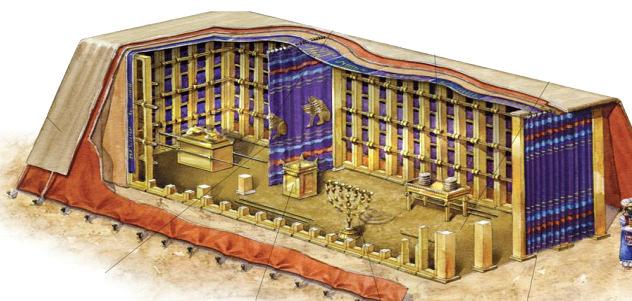
The Curtains that Covered the Tabernacle
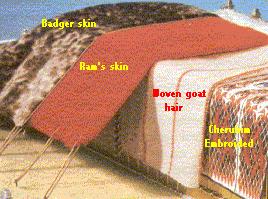
Ten curtains made of fine linen, which were twenty-eight cubits long and four cubits wide covered the tabernacle.† Also there were eleven curtain coverings that were made of goatís hair. Using the ancient computation of 21.888 inches for the sacred cubit, would put the length of the cherubim embroidered curtains as 51.1 feet long and 72.9 feet wide.† Yet in some ancient calculations, the cubits were 18 inches.† This would make the covering 42 feet by 30 feet.
Cloud the and Pillars of Fire
Everything in the tabernacle was portable so that if the cloud of glory moved, they moved with it and the ark would lead the way. During the day, the Holy Tabernacle was always covered by a pillar of cloud, and in the night by a pillar of fire. As long as the pillar of cloud rested over the Tabernacle, the children of Israel remained in the same place. When the cloud rose up, it was a sign for them to continue their journey. Thus they camped and traveled according to God's command.
Everything in the tabernacle was portable so that if the cloud of glory moved, they moved with it and the ark would lead the way. During the day, the Holy Tabernacle was always covered by a pillar of cloud, and in the night by a pillar of fire. As long as the pillar of cloud rested over the Tabernacle, the children of Israel remained in the same place. When the cloud rose up, it was a sign for them to continue their journey. Thus they camped and traveled according to God's command.
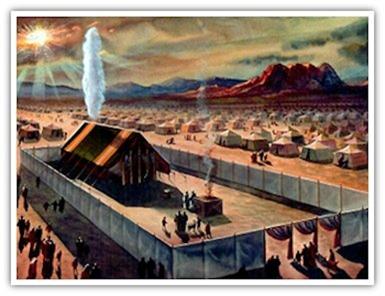
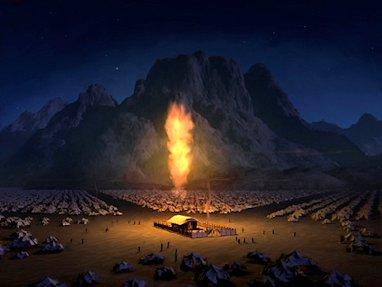
The Ark of the Covenant
The ark (Exo:25:10-22), commonly known as the ark of the covenant, was the most sacred of all the furniture in the tabernacle. A chest that measured approximately 45 inches long, 27 inches wide, and 27 inches deep, it held three priceless items: a copy of the stone tablets on which the Ten Commandments were written (Exo:25:16, Exo:25:21), a golden pot of manna from the wilderness journey (Exo_16:32-34), and Aaron's rod that budded (Num:17:1-11).
The ark (Exo:25:10-22), commonly known as the ark of the covenant, was the most sacred of all the furniture in the tabernacle. A chest that measured approximately 45 inches long, 27 inches wide, and 27 inches deep, it held three priceless items: a copy of the stone tablets on which the Ten Commandments were written (Exo:25:16, Exo:25:21), a golden pot of manna from the wilderness journey (Exo_16:32-34), and Aaron's rod that budded (Num:17:1-11).
The ark was a chest made of acacia wood, overlaid with pure gold inside and out.
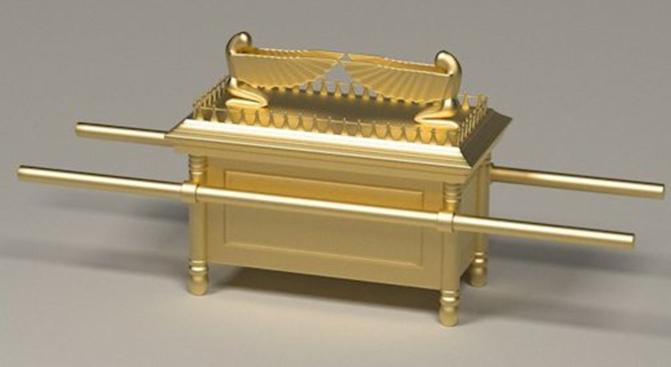
The mercy seat. Exodus 25:17 The mercy seat was the lid for the ark as well as the base on which the cherubim were to be placed. The cherubim's wings stretched out and faced inward, shading the mercy seat. Their faces gazed on the mercy seat itself. In the old covenant, the mercy seat was a place of propitiation for sin, resulting in peace with God. For ancient Israelites, the mercy seat had a meaning similar to that of the Cross for Christians.
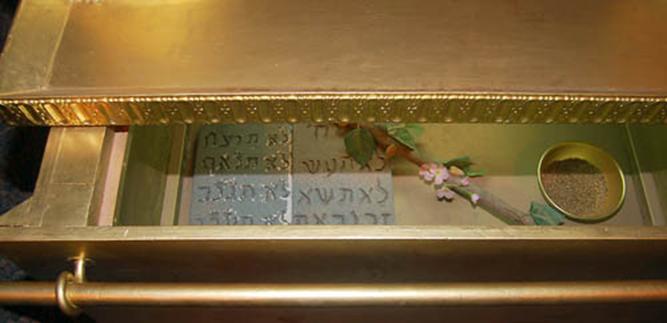
The contents were the second set of stone tablets on which the Ten Commandments were written (Exo:25:16, Exo:25:21), a golden pot of manna from the wilderness journey (Exo_16:32-34), and Aaron's rod that budded (Num:17:1-11).
The 7 Pieces of Furniture
God gave the specific order for the arrangement of the furniture (Exodus 40:20-38). If you could trace a line around their divine order the following would appear (the ark and mercy seat are two pieces forming one).
God gave the specific order for the arrangement of the furniture (Exodus 40:20-38). If you could trace a line around their divine order the following would appear (the ark and mercy seat are two pieces forming one).
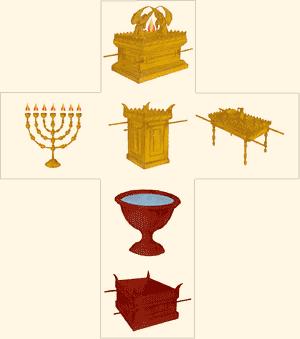
The tabernacle and its rituals are called a ďshadow of good things to comeĒ; the salvation of Jesus Christ Ė of which He is the substance (Hebrews 9:9-11, 10:1, Colossians 2:17). Many still focus on religious rituals rather than receiving the reality - the Lord Jesus Christ as their Lord and Savior. They are chasing shadows. They are like a husband who sees the shadow of his bride appearing as she is ready to walk down the aisle. He then ignores his bride and embraces her shadow. Are you chasing shadows or have you embraced the only living Savior?
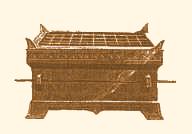
1. The Altar of Sacrifice
The first piece a worshipper would encounter as he came through the door was the altar. It was wood covered with brass (or copper at that time). It was a perfect square with horns on each of the 4 corners. It was where the blood sacrifices of clean lambs and goats would be offered in the heat of fire unto God for atonement (the covering and forgiveness of sins) (Exodus 27:1-8, Leviticus 17:11).
The first piece a worshipper would encounter as he came through the door was the altar. It was wood covered with brass (or copper at that time). It was a perfect square with horns on each of the 4 corners. It was where the blood sacrifices of clean lambs and goats would be offered in the heat of fire unto God for atonement (the covering and forgiveness of sins) (Exodus 27:1-8, Leviticus 17:11).
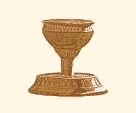
2. The Laver of Washing
The second piece of furniture was a washing basin for the priests called the laver (lavatory Ė place of washing). It came after the altar of sacrifice and before the entrance to the sanctuary. It was made of polished copper. Its purpose was ďto washĒ. The priests had to daily wash their hands and feet from dirt and contamination before they worshipped God at the altar or entered the sanctuary to serve. The laver was for the washing of dirt. One had to be clean to serve. (Exodus 30:18-21).
The second piece of furniture was a washing basin for the priests called the laver (lavatory Ė place of washing). It came after the altar of sacrifice and before the entrance to the sanctuary. It was made of polished copper. Its purpose was ďto washĒ. The priests had to daily wash their hands and feet from dirt and contamination before they worshipped God at the altar or entered the sanctuary to serve. The laver was for the washing of dirt. One had to be clean to serve. (Exodus 30:18-21).
The Holy Place
(The First Sanctuary with 3 Pieces of Furniture)
(The First Sanctuary with 3 Pieces of Furniture)
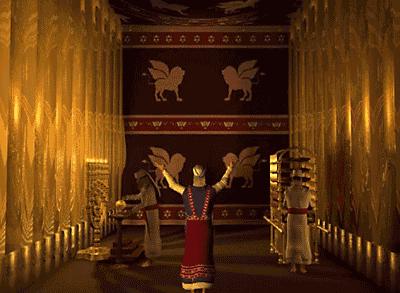
The holy place contained gold not copper: the golden lampstand, the golden table of bread and the golden altar of incense. Here the washed priests entered to perform service and representative worship unto the Lord. This section tells that God is not only interested in our forgiveness and daily cleanliness but also our worship.
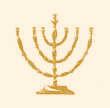
3. The Golden Lampstand
On the south side of the holy place stood the pure golden lampstand. The gold was formed into the shape of an almond tree in the full bloom of life by beating or hammering. It had six fruitful branches with a central shaft or trunk. They were designed to hold seven bowls filled with olive oil to provide light. Light and life merged together in one unit. The light was continual and was never to go out.
On the south side of the holy place stood the pure golden lampstand. The gold was formed into the shape of an almond tree in the full bloom of life by beating or hammering. It had six fruitful branches with a central shaft or trunk. They were designed to hold seven bowls filled with olive oil to provide light. Light and life merged together in one unit. The light was continual and was never to go out.
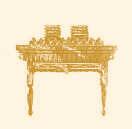
4. The Golden Table of Showbread
Directly opposite the lampstand stood the table of showbread on the north side. One could only see the bread by the one light. Twelve loaves of bread were set on it once a week. During the week the bread was to be displayed before God. On the Sabbath the priests were to eat it. Thus God and man shared the same table together in fellowship of the same bread.
Directly opposite the lampstand stood the table of showbread on the north side. One could only see the bread by the one light. Twelve loaves of bread were set on it once a week. During the week the bread was to be displayed before God. On the Sabbath the priests were to eat it. Thus God and man shared the same table together in fellowship of the same bread.

5. The Golden Altar of Incense
The third and last piece of furniture in the holy place was the altar of incense with its four horns. This stood by the veil, which separated the holy place from the holiest of holies. This altar was for one purpose only: to burn incense, not sacrifice. The incense was a special God-prescribed formula, which sent out a rich fragrant smoke when the priest lit it at morning and evening.
The third and last piece of furniture in the holy place was the altar of incense with its four horns. This stood by the veil, which separated the holy place from the holiest of holies. This altar was for one purpose only: to burn incense, not sacrifice. The incense was a special God-prescribed formula, which sent out a rich fragrant smoke when the priest lit it at morning and evening.
The Holiest of Holies
(The Second Sanctuary with 2 Pieces of Furniture)
(The Second Sanctuary with 2 Pieces of Furniture)
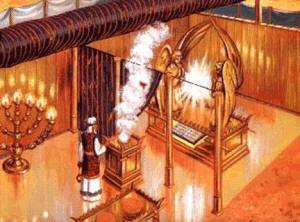
The holiest place of all contained the Ark of the Covenant covered with a special lid called the mercy seat. This was where Godís presence resided and where He communed (talked) with Moses (Exodus 25:22). The veil or curtain blocked the way so others could not enter in. However, the minute the Lord Jesus died on the cross the veil, then in the temple, was split in two showing the way was now made for all to come into the communion with God (Matthew 27:51, Hebrews 9:7-8, 10:19-21).
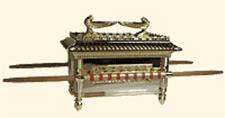
6&7 The Golden Ark and Mercy Seat
The Ark was a chest made out of wood covered with gold and a crown border like the table and incense altar. It, however, rested in the holiest place where the presence of God dwelt.
The Mercy Seat was the cover of the ark. It was solid gold with winged cherubim; one at each end looking down where Godís presence was. Here, once a year, the high priest alone went in with sacrificial blood from the brazen altar to sprinkle it on the mercy
seat to obtain forgiveness of sins for Israel.
The Ark was a chest made out of wood covered with gold and a crown border like the table and incense altar. It, however, rested in the holiest place where the presence of God dwelt.
The Mercy Seat was the cover of the ark. It was solid gold with winged cherubim; one at each end looking down where Godís presence was. Here, once a year, the high priest alone went in with sacrificial blood from the brazen altar to sprinkle it on the mercy
seat to obtain forgiveness of sins for Israel.
History of the Temple
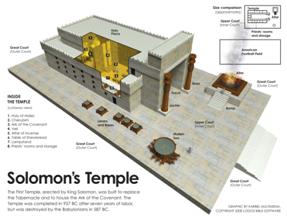
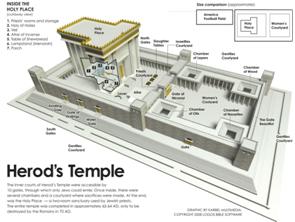
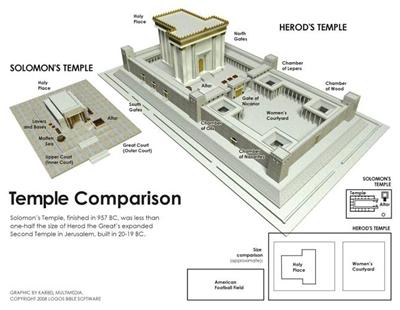
The crowning achievement of King Solomonís reign was the erection of a magnificent temple in Jerusalem, often called Solomonís temple or the first temple. Solomonís father, King David, had wanted to build a great temple for God a generation earlier, as a permanent resting place for the Ark of the Covenant which contained the Ten Commandments. However, God had forbidden him from doing so: "You will not build a house for my name for you are a man of battles and have shed blood" (1 Chronicles 28:3). Then Solomon began to build the house of the LORD in Jerusalem on Mount Moriah, where the Lord had appeared to his father David (2 Chronicles 3:1). This new, stationary temple would replace the portable tabernacle constructed during the wilderness wandering.
If Solomon reigned from 970 to 930 BC, then he began building the temple in 966 BC. A very interesting fact concerning the building of the temple was there was no noise of the construction. The material was prepared before it was brought to the building site. The house, while it was being built, was built of stone prepared at the quarry, and there was neither hammer nor axe nor any iron tool heard in the house while it was being built (1 Kings 6:7). The Bibleís description of Solomonís temple suggests that the inside ceiling was 180 feet long, 90 feet wide, and 50 feet high. The highest point on the temple that King Solomon built was actually 120 cubits tall (about 20 stories or about 207 feet). First Kings 6:1Ė38 and chapters 7ó8 describe the construction and dedication of Solomonís temple.
Until the first temple was destroyed by the Babylonians some four hundred years later, in 586 BC, sacrifice was the predominant mode of divine service there. Seventy years later, a second temple was completed on the same site, and sacrifices again resumed. The book of Ezra chronicles the building of the second temple. During the first century, Herod greatly enlarged and expanded this temple, which became known as Herodís temple. It was destroyed by the Romans in AD 70, during the siege of Jerusalem.
So the presence of God remained shielded from man behind a thick curtain during the history of Israel. However, Jesusí sacrificial death on the cross changed that. When He died, the curtain in the Jerusalem temple was torn in half, from the top to the bottom. Only God could have carried out such an incredible feat because the veil was too high for human hands to have reached it, and too thick to have torn it. (The Jerusalem temple, a replica of the wilderness tabernacle, had a curtain that was about 60 feet in height, 30 feet in width and 4 inches thick.) Furthermore, it was torn from top down, meaning this act had to come from above.
Until the first temple was destroyed by the Babylonians some four hundred years later, in 586 BC, sacrifice was the predominant mode of divine service there. Seventy years later, a second temple was completed on the same site, and sacrifices again resumed. The book of Ezra chronicles the building of the second temple. During the first century, Herod greatly enlarged and expanded this temple, which became known as Herodís temple. It was destroyed by the Romans in AD 70, during the siege of Jerusalem.
So the presence of God remained shielded from man behind a thick curtain during the history of Israel. However, Jesusí sacrificial death on the cross changed that. When He died, the curtain in the Jerusalem temple was torn in half, from the top to the bottom. Only God could have carried out such an incredible feat because the veil was too high for human hands to have reached it, and too thick to have torn it. (The Jerusalem temple, a replica of the wilderness tabernacle, had a curtain that was about 60 feet in height, 30 feet in width and 4 inches thick.) Furthermore, it was torn from top down, meaning this act had to come from above.
History of the Ark
The Ark accompanied the Jews throughout their time in the desert, traveling with them and accompanying them to their wars with Emor and Midian. When the Jews crossed into the land of Canaan, the waters of the Jordan River miraculously split and the Ark led them through (Josh. 3). Throughout their conquest of the land, the Jews were accompanied by the Ark. The most dramatic demonstration of its power comes when the Jews breached the walls of Jericho merely by circling them, blowing horns and carrying the Ark (Josh. 6).
After the conquest was completed, the Ark, and the entire Tabernacle, were set up in Shiloh (Josh. 18) . There they remained until the battles of the Jews with the Philistines during the Priesthood of Eli. The Jews, after suffering a defeat at the Philistines' hands, took the Ark from Shiloh to Even-Ezer in hopes of winning the next battle. But the Jews were routed, and the Ark was captured by the Philistines. Back in Shiloh, Eli, the High Priest, immediately died upon hearing the news (I Sam. 4).
The Philistines took the Ark back to Ashdod, their capital city in the south of Canaan, where they placed it in the temple of their god Dagon. The next day, however, they found the idol fallen on its face. After replacing the statue, they found it the next day decapitated, with only its trunk remaining, and soon afterward, the entire city of Ashdod was struck with a plague. The Philistines moved the Ark to the city of Gath, and from there to Ekron, but whatever city the Ark was in, the inhabitants were struck with plague. After seven months, the Philistines decided to send the Ark back to the Israelites, and accompanied it with expensive gifts but it would never again sit in the tabernacle of Moses. It was taken to Abinadab's house (I Sam. 7:1).
The Ark was eventually transported to Kiryat Yearim, where it remained for twenty years. From there, King David transported it to Jerusalem. En route, however, the oxen pulling it stumbled, and when Uzzah reached out to steady the Ark, he died immediately. As a result of this tragedy, David decided to leave the Ark at the home of Obed-edom the Gittite. Three months later, he moved it to Jerusalem, the seat of his kingdom, where it remained until the construction of the First Temple by David's son Solomon (I Sam. 5-6).
Although there are many theories behind where the ark of the covenant currently resides, one thing is certain, archaeology has already proven its existence. In Jerusalem, the golden roof on the Muslim shrine of the "Dome of the Rock" towers over the site where the Jewish temple once stood. Its foundation is a massive rock on which archaeologists have laid out all the rooms of the old Jewish temple including the Holy of Holies.
The Holy of Holies is the room where the ark of the covenant was kept. To this very day a rectangular depression, the same size as the ark of the covenant, can be seen marking where it once stood in the Jewish Temple. The depression measures 4'-4" x 2'-7" (2 Ĺ cubits x 1 Ĺ cubits), the exact dimensions of the Ark of the Covenant as recorded in "Exodus 25:10". And it is located right smack dab in the middle of the Holy of Holies.
After the conquest was completed, the Ark, and the entire Tabernacle, were set up in Shiloh (Josh. 18) . There they remained until the battles of the Jews with the Philistines during the Priesthood of Eli. The Jews, after suffering a defeat at the Philistines' hands, took the Ark from Shiloh to Even-Ezer in hopes of winning the next battle. But the Jews were routed, and the Ark was captured by the Philistines. Back in Shiloh, Eli, the High Priest, immediately died upon hearing the news (I Sam. 4).
The Philistines took the Ark back to Ashdod, their capital city in the south of Canaan, where they placed it in the temple of their god Dagon. The next day, however, they found the idol fallen on its face. After replacing the statue, they found it the next day decapitated, with only its trunk remaining, and soon afterward, the entire city of Ashdod was struck with a plague. The Philistines moved the Ark to the city of Gath, and from there to Ekron, but whatever city the Ark was in, the inhabitants were struck with plague. After seven months, the Philistines decided to send the Ark back to the Israelites, and accompanied it with expensive gifts but it would never again sit in the tabernacle of Moses. It was taken to Abinadab's house (I Sam. 7:1).
The Ark was eventually transported to Kiryat Yearim, where it remained for twenty years. From there, King David transported it to Jerusalem. En route, however, the oxen pulling it stumbled, and when Uzzah reached out to steady the Ark, he died immediately. As a result of this tragedy, David decided to leave the Ark at the home of Obed-edom the Gittite. Three months later, he moved it to Jerusalem, the seat of his kingdom, where it remained until the construction of the First Temple by David's son Solomon (I Sam. 5-6).
Although there are many theories behind where the ark of the covenant currently resides, one thing is certain, archaeology has already proven its existence. In Jerusalem, the golden roof on the Muslim shrine of the "Dome of the Rock" towers over the site where the Jewish temple once stood. Its foundation is a massive rock on which archaeologists have laid out all the rooms of the old Jewish temple including the Holy of Holies.
The Holy of Holies is the room where the ark of the covenant was kept. To this very day a rectangular depression, the same size as the ark of the covenant, can be seen marking where it once stood in the Jewish Temple. The depression measures 4'-4" x 2'-7" (2 Ĺ cubits x 1 Ĺ cubits), the exact dimensions of the Ark of the Covenant as recorded in "Exodus 25:10". And it is located right smack dab in the middle of the Holy of Holies.
The Temple Curtain Torn
The temple of Jesusís day was new. Solomonís temple had long ago been destroyed by the Babylonians. It was rebuilt under great stress in the time of Ezra and Nehemiah with the help of Darius king of Medopersia. However it was inferior to Solomonís temple and the one Ezekiel saw in visions. Centuries later, about twenty years before Jesus came, work commenced to replace this temple with the magnificent structure still being completed at the time the disciples of Jesus admired it and Jesus ironically but accurately foretold its destruction (Matthew 24:1-2).
Later, at our Lordís crucifixion, the great curtain veiling the Holiest place was torn from top to bottom (Mat 27:51 and Mark 15:38). Remember that this curtain in Herod's temple would have been nearly 60 feet in height, 30 feet in width and 4 inches thick.
Later, at our Lordís crucifixion, the great curtain veiling the Holiest place was torn from top to bottom (Mat 27:51 and Mark 15:38). Remember that this curtain in Herod's temple would have been nearly 60 feet in height, 30 feet in width and 4 inches thick.
What Did the Ark of the Covenant Contain (Hebrews 9:4 or 1st Kings 8:9)?
I Kings 8:9 and Hebrews 9:4 may seem to contradict each other but we know God's Word does not contradict itself. Letís take a look at these scriptures
1Ki 8:9 There was nothing in the ark except the two stone tablets that Moses had placed in it at
Horeb, where the LORD made a covenant with the Israelites after they came out of Egypt.
Heb 9:4 which had the golden altar of incense and the gold-covered ark of the covenant. This ark
contained the gold jar of manna, Aaron's staff that had budded, and the stone tablets of
the covenant.
One verse says that only the two stone tablets inscribed with the Ten Commandments were in the ark. The other verse lists several additional objects which apparently were also in the ark. However, God's Word does not contradict itself.
Commentator Albert Barnes, writing on Hebrews 9:4 says this::
It is clear from the passage in I Kings 8:9, that they were not in the ark in the temple, but there is no improbability in the supposition that before the temple was built they might have been removed from the ark and lost. When the ark was carried from place to place, or during its captivity by the Philistines, it is probable that they were lost, as we never hear of them afterward.
In any case, there is no contradiction between I Kings 8:9 and Hebrews 9:4. The author of I Kings describes the ark's contents when it was installed in the First Temple, while Paul speaks of what Moses had put in it or with it in the wilderness several hundred years before the Temple was built.
1Ki 8:9 There was nothing in the ark except the two stone tablets that Moses had placed in it at
Horeb, where the LORD made a covenant with the Israelites after they came out of Egypt.
Heb 9:4 which had the golden altar of incense and the gold-covered ark of the covenant. This ark
contained the gold jar of manna, Aaron's staff that had budded, and the stone tablets of
the covenant.
One verse says that only the two stone tablets inscribed with the Ten Commandments were in the ark. The other verse lists several additional objects which apparently were also in the ark. However, God's Word does not contradict itself.
Commentator Albert Barnes, writing on Hebrews 9:4 says this::
It is clear from the passage in I Kings 8:9, that they were not in the ark in the temple, but there is no improbability in the supposition that before the temple was built they might have been removed from the ark and lost. When the ark was carried from place to place, or during its captivity by the Philistines, it is probable that they were lost, as we never hear of them afterward.
In any case, there is no contradiction between I Kings 8:9 and Hebrews 9:4. The author of I Kings describes the ark's contents when it was installed in the First Temple, while Paul speaks of what Moses had put in it or with it in the wilderness several hundred years before the Temple was built.
Summary
Priests entered into the Temple every morning and every evening to offer the morning incense and the evening incense. Once a week they would enter to change the bread on the Table of Shewbread. These were acts of prayer and of worship. But these priests were not permitted to go any further than the inner veil. Only one priest was allowed to pass beyond the veil. He was the high priest. And he was only permitted to do so once a year. It would be on the Day of Atonement that the High Priest would pass through the veil and into the holy of holies. He would approach the Ark of the Covenant. Upon the top of the Ark was a lid of solid gold. This was known as the Mercy Seat. The images of two cherubim face the center of the Ark. They were silent guardians of the presence of God. The high priest would sprinkle the blood of sacrificed animals upon the Mercy Seat. By this he was providing an atonement for the sins of the entire nation. No mere animalís death could ever take away sins. No mere animalís blood could ever take away guilt. Such rituals were only temporary.
When Jesus was crucified on the cross some amazing and wonderful things happened. He made the supreme sacrifice and gave his life for us and for the sins of the world that changed history. When He died, the curtain in the Jerusalem temple was torn in half, from the top to the bottom.
The holy of holiest room in the inner chamber was no more. Jesus offered himself as a sacrifice once and for all so that everyone could come to God through Jesus. Jesus said in (Joh 14:6 "I am the way, the truth, and the life. No one comes to the Father except through Me).
We have now been given the great privilege and honor of going straight to God in the name of Jesus. We no longer go to priest like they did in the old testament under the old law.
(1Tim 2:5 says: (For there is one God and one Mediator between God and men, the Man Christ Jesus,). We have only one priest and that is Jesus. We are also instructed to call no one father as they did in the old testament. Jesus said in Mat 23:9 Do not call anyone on earth your father; for One is your Father, He who is in heaven.
We have a new covenant that was created when Jesus died for us. The old covenant was written in stone, but the new covenant is written on our hearts. Salvation is just a prayer away. (1Jn 1:9 says: If we confess our sins, He is faithful and just to forgive us our sins and to cleanse us from all unrighteousness). There is only one way to be forgiven of your sins and that is through Jesus. There is no other way.
Eph 2:8 For by grace you have been saved through faith, and that not of yourselves; it is the gift of God,
Eph 2:9 not of works, lest anyone should boast.
Rom 10:13 For whosoever shall call upon the name of the Lord shall be saved.
When Jesus was crucified on the cross some amazing and wonderful things happened. He made the supreme sacrifice and gave his life for us and for the sins of the world that changed history. When He died, the curtain in the Jerusalem temple was torn in half, from the top to the bottom.
The holy of holiest room in the inner chamber was no more. Jesus offered himself as a sacrifice once and for all so that everyone could come to God through Jesus. Jesus said in (Joh 14:6 "I am the way, the truth, and the life. No one comes to the Father except through Me).
We have now been given the great privilege and honor of going straight to God in the name of Jesus. We no longer go to priest like they did in the old testament under the old law.
(1Tim 2:5 says: (For there is one God and one Mediator between God and men, the Man Christ Jesus,). We have only one priest and that is Jesus. We are also instructed to call no one father as they did in the old testament. Jesus said in Mat 23:9 Do not call anyone on earth your father; for One is your Father, He who is in heaven.
We have a new covenant that was created when Jesus died for us. The old covenant was written in stone, but the new covenant is written on our hearts. Salvation is just a prayer away. (1Jn 1:9 says: If we confess our sins, He is faithful and just to forgive us our sins and to cleanse us from all unrighteousness). There is only one way to be forgiven of your sins and that is through Jesus. There is no other way.
Eph 2:8 For by grace you have been saved through faith, and that not of yourselves; it is the gift of God,
Eph 2:9 not of works, lest anyone should boast.
Rom 10:13 For whosoever shall call upon the name of the Lord shall be saved.











